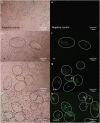Protective Effects of Cell-Free Supernatant and Live Lactic Acid Bacteria Isolated from Thai Pigs Against a Pandemic Strain of Porcine Epidemic Diarrhea Virus
- PMID: 28434154
- PMCID: PMC7091344
- DOI: 10.1007/s12602-017-9281-y
Protective Effects of Cell-Free Supernatant and Live Lactic Acid Bacteria Isolated from Thai Pigs Against a Pandemic Strain of Porcine Epidemic Diarrhea Virus
Abstract
Porcine epidemic diarrhea virus (PEDV) is a coronavirus which causes severe diarrhea and fatal dehydration in piglets. In general, probiotic supplements could enhance recovery and protect piglets against enteric pathogens. Seven local lactic acid bacteria (LAB), (Ent. faecium 79N and 40N, Lact. plantarum 22F, 25F and 31F, Ped. acidilactici 72N and Ped. pentosaceus 77F) from pig feces were well-characterized as high potential probiotics. Cell-free supernatants (CFS) and live LAB were evaluated for antiviral activities by co-incubation on Vero cells and challenged with a pandemic strain of PEDV isolated from pigs in Thailand. Cell survival and viral inhibition were determined by cytopathic effect (CPE) reduction assay and confirmed by immunofluorescence. At 1:16, CFS dilution (pH 6.3-6.8) showed no cytotoxicity in Vero cells and was therefore used as the dilution for antiviral assays. The diluted CFS of all Lact. plantarum showed the antiviral effect against PEDV; however, the same antiviral effect could not be observed in Ent. faecium and Pediococcus strains. In competitive experiment, only live Lact. plantarum 25F and Ped. pentosaceus 77F showed CPE reduction in the viral infected cells to <50% observed field area. This study concluded that the CFS of all tested lactobacilli, and live Lact. plantarum (22F and 25F) and Pediococcus strains 72N and 77F could reduce infectivity of the pandemic strain of PEDV from pigs in Thailand on the target Vero cells.
Keywords: Antiviral activity; Cell-free supernatants; Lactic acid bacteria; Porcine epidemic diarrhea virus; Probiotics.
Conflict of interest statement
The authors declare that they have no conflict of interest.
Figures



Similar articles
-
Autochthonous lactic acid bacteria isolated from pig faeces in Thailand show probiotic properties and antibacterial activity against enteric pathogenic bacteria.Microb Pathog. 2018 Jun;119:208-215. doi: 10.1016/j.micpath.2018.04.031. Epub 2018 Apr 17. Microb Pathog. 2018. PMID: 29678738
-
Screening of Lactic Acid Bacterial Strains with Antiviral Activity Against Porcine Epidemic Diarrhea.Probiotics Antimicrob Proteins. 2022 Jun;14(3):546-559. doi: 10.1007/s12602-021-09829-w. Epub 2021 Aug 4. Probiotics Antimicrob Proteins. 2022. PMID: 34350565
-
Porcine epidemic diarrhea vaccine evaluation using a newly isolated strain from Korea.Vet Microbiol. 2018 Jul;221:19-26. doi: 10.1016/j.vetmic.2018.05.012. Epub 2018 May 24. Vet Microbiol. 2018. PMID: 29981703
-
Porcine epidemic diarrhea virus infection: Etiology, epidemiology, pathogenesis and immunoprophylaxis.Vet J. 2015 May;204(2):134-43. doi: 10.1016/j.tvjl.2015.02.017. Epub 2015 Feb 26. Vet J. 2015. PMID: 25841898 Free PMC article. Review.
-
[Porcine epidemic diarrhea].Vopr Virusol. 2009 Mar-Apr;54(2):4-8. Vopr Virusol. 2009. PMID: 19459405 Review. Russian.
Cited by
-
Infantile Colic Treated With Bifidobacterium longum CECT7894 and Pediococcus pentosaceus CECT8330: A Randomized, Double-Blind, Placebo-Controlled Trial.Front Pediatr. 2021 Sep 10;9:635176. doi: 10.3389/fped.2021.635176. eCollection 2021. Front Pediatr. 2021. PMID: 34568236 Free PMC article.
-
Antiviral potentials of Lactobacillus plantarum, Lactobacillus amylovorus, and Enterococcus hirae against selected Enterovirus.Folia Microbiol (Praha). 2019 Mar;64(2):257-264. doi: 10.1007/s12223-018-0648-6. Epub 2018 Sep 29. Folia Microbiol (Praha). 2019. PMID: 30267215
-
Advances research in porcine enteric coronavirus therapies and antiviral drugs.Vet Q. 2024 Dec;44(1):1-49. doi: 10.1080/01652176.2024.2421299. Epub 2024 Nov 1. Vet Q. 2024. PMID: 39484691 Free PMC article. Review.
-
Complete genome sequencing and probiotic characterization of promising lactic acid bacterial strains isolated from dairy products in Egyptian markets.BMC Microbiol. 2025 Feb 6;25(1):67. doi: 10.1186/s12866-025-03757-3. BMC Microbiol. 2025. PMID: 39915700 Free PMC article.
-
The efficacy of three double-microencapsulation methods for preservation of probiotic bacteria.Sci Rep. 2021 Jul 2;11(1):13753. doi: 10.1038/s41598-021-93263-z. Sci Rep. 2021. PMID: 34215824 Free PMC article.
References
-
- Di-qiu L, Jun-wei G, Xin-yuan Q, Yan-ping J, Song-mei L, Yi-jing L. High-level mucosal and systemic immune responses induced by oral administration with lactobacillus-expressed porcine epidemic diarrhea virus (PEDV) S1 region combined with lactobacillus-expressed N protein. Appl Microbiol Biot. 2012;93(6):2437–2446. doi: 10.1007/s00253-011-3734-0. - DOI - PMC - PubMed
Publication types
MeSH terms
LinkOut - more resources
Full Text Sources
Other Literature Sources
Research Materials
Miscellaneous

